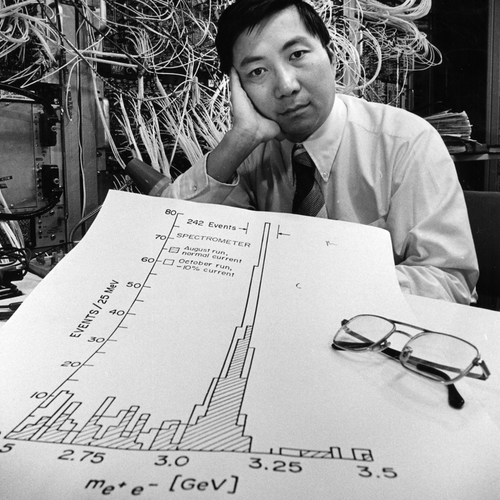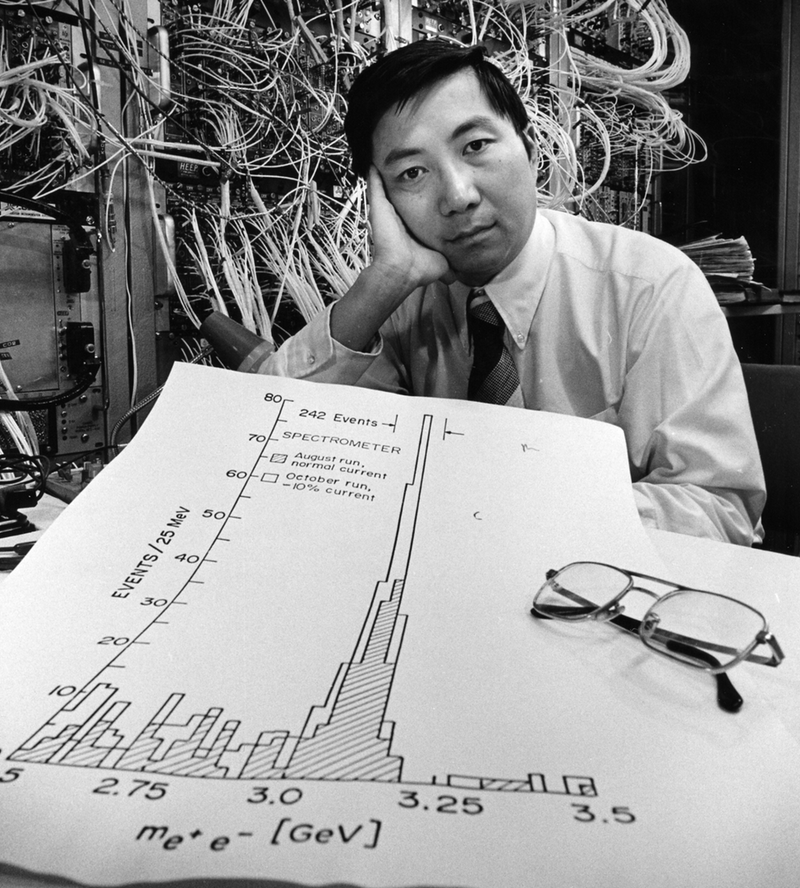Landmarks—The Charming Debut of a New Quark
Landmarks articles feature important papers from the archives of the Physical Review journals.
In 1974, two groups using new accelerators and detectors found a particle that, according to the three-quark model then prevalent, shouldn’t have existed. Dubbed the J∕𝜓 (“Jay-psi”) because the two teams gave it different names, the particle was soon recognized as evidence for a fourth quark type, named charm. A Nobel prize for both teams followed quickly in 1976, and still today the J∕𝜓 and its cousins are powerful experimental tools for studying the theory of quark physics.
The original quark model, proposed in 1964, used three quarks—up, down, and strange—to account for the particles collectively known as hadrons. The proton and neutron were combinations of three quarks, while pions, kaons, and other mesons were pairs of quarks. For about ten years, the three-quark model proved highly successful in explaining not only these existing particles, but also new, short-lived mesons that physicists found as they pushed accelerator energies higher.
In 1972, a new machine called SPEAR came into operation at the Stanford Linear Accelerator Center (SLAC) in California. In SPEAR, electrons collided with positrons with total energy varying from 2.6 to 8 GeV. In 1974, Burton Richter of SLAC and his colleagues began experiments to compare the production rates for two possible outcomes of electron-positron collisions—hadrons and muon-antimuon pairs. The ratio of these two rates could be compared with theoretical predictions to test the latest models.
The team increased the collision energy in steps of 0.2 GeV and found that the ratio rose fairly smoothly. This was already a problem for the three-quark model, which predicted that the ratio should remain constant. But the team also saw signs of a blip in the data at 3.2 GeV and scanned that region with finer energy resolution. They found a high and extremely narrow peak at 3.1 GeV. Experiments of this sort often produced broad peaks, known as resonances, indicating the production of a barely stable hadronic particle with an extremely short lifetime. The narrowness of the peak that Richter and his team found was a clear sign that collisions had produced a new and relatively long-lived hadronic particle, which they named 𝜓. “Nothing so strange and unexpected had happened in particle physics for many years,” said Richter in his Nobel Prize lecture.
During this same period, Sam Ting of the Massachusetts Institute of Technology and his colleagues were exploring hadronic physics at the Alternating Gradient Synchrotron (AGS) at Brookhaven National Laboratory on Long Island, New York. They smashed 30-GeV protons into a beryllium target and used a complex arrangement of magnetic fields and detectors to filter out interesting results from the debris. They looked for events in which an initial proton-proton collision created an intermediate particle that then decayed into an electron-positron pair. The difficulty of the experiment lay in identifying electrons and positrons with energies and directions indicating that they were the products of such a decay.
Over the summer of 1974, Ting and his colleagues found strong evidence that a hadron with mass 3.1 GeV was being produced, but the tricky nature of the experiments made Ting cautious about announcing the results. Early in November, however, he heard of the new results coming from Richter’s group, and the two teams published their findings in the same issue of Physical Review Letters. Ting named the particle J, and the J∕𝜓 designation stuck.
Ting’s paper mentioned a number of ideas for the identity of the particle, including the possibility, attributed to Harvard theorist Sheldon Glashow, that it might be “one of the theoretically suggested charmed particles.” Charm was the name given to a hypothetical fourth quark, an idea that Glashow had helped originate in 1964 [1]. That possibility quickly gained traction, but it took a number of further experiments for researchers to establish that the J∕𝜓 was in fact the first excited state of a meson consisting of a charm-anticharm quark pairing.
Charmonium, as the new combination was dubbed, became so well understood over the years following its discovery that it proved invaluable as a test object for calculations using quantum chromodynamics (QCD), the theory of strong interactions, says Josef Dudek of Old Dominion University in Norfolk, Virginia. But he says that the recent advent of machines that can produce mesons by the billion has led to the discovery of small departures from theoretical expectation that are pushing theorists to further improve the accuracy of QCD calculations.
This research is published in Physical Review Letters.
–David Lindley
David Lindley is a freelance science writer, now retired. His most recent book is The Dream Universe: How Fundamental Physics Lost Its Way (Penguin Random House, 2020).
References
- B. J. Bjørken and S. L. Glashow, “Elementary Particles and SU(4),” Phys. Lett. 11, 255 (1964).





